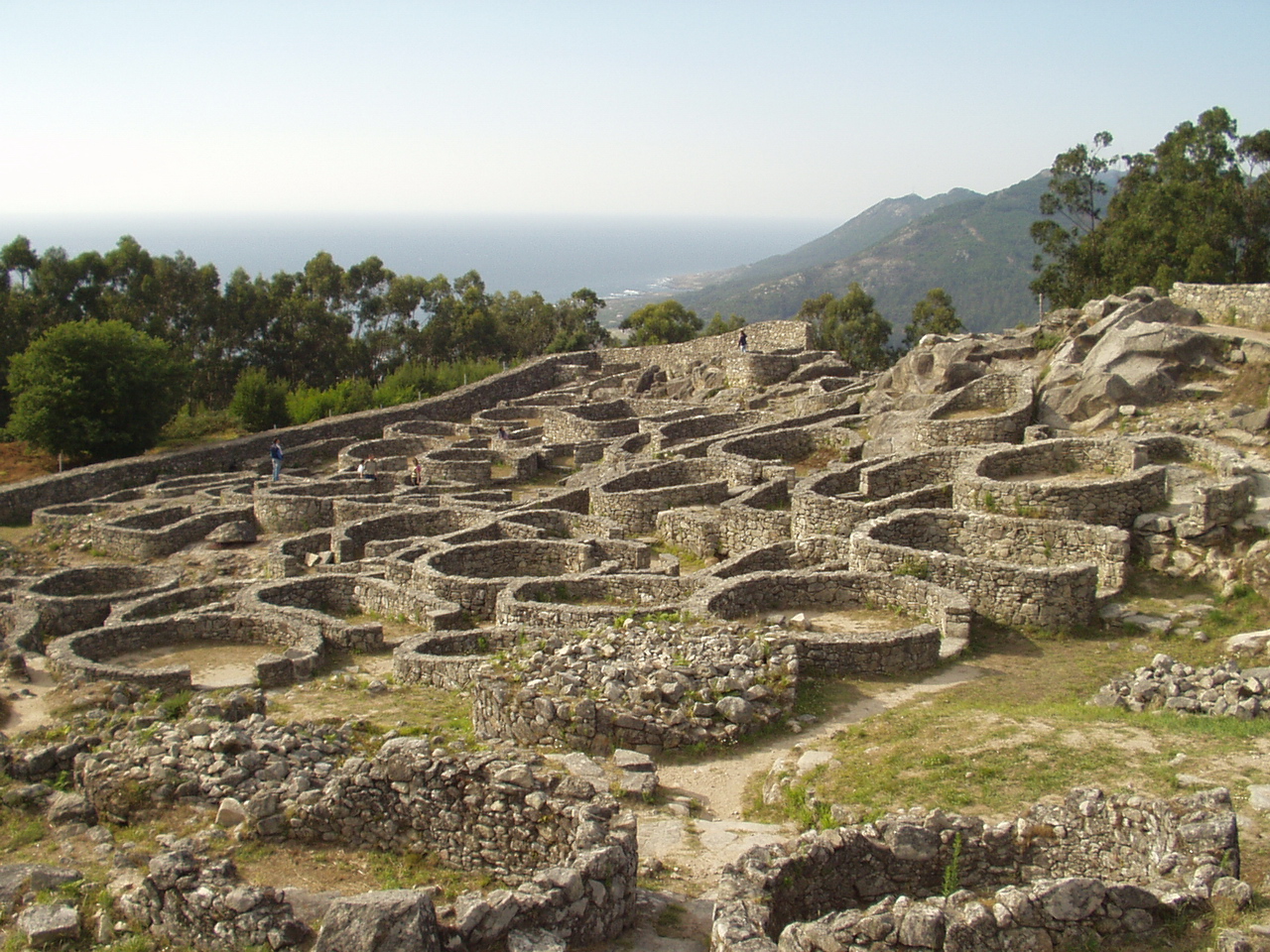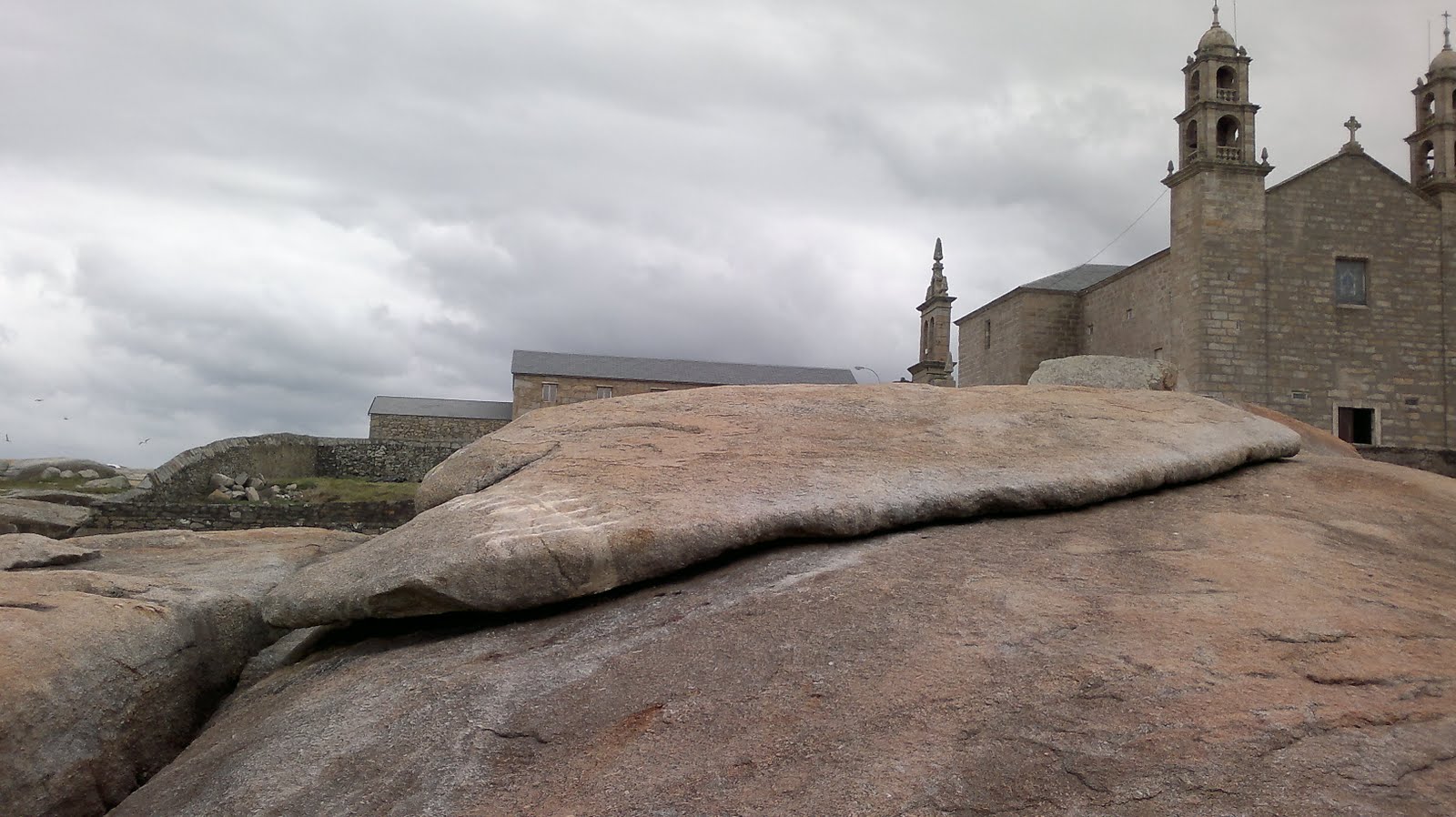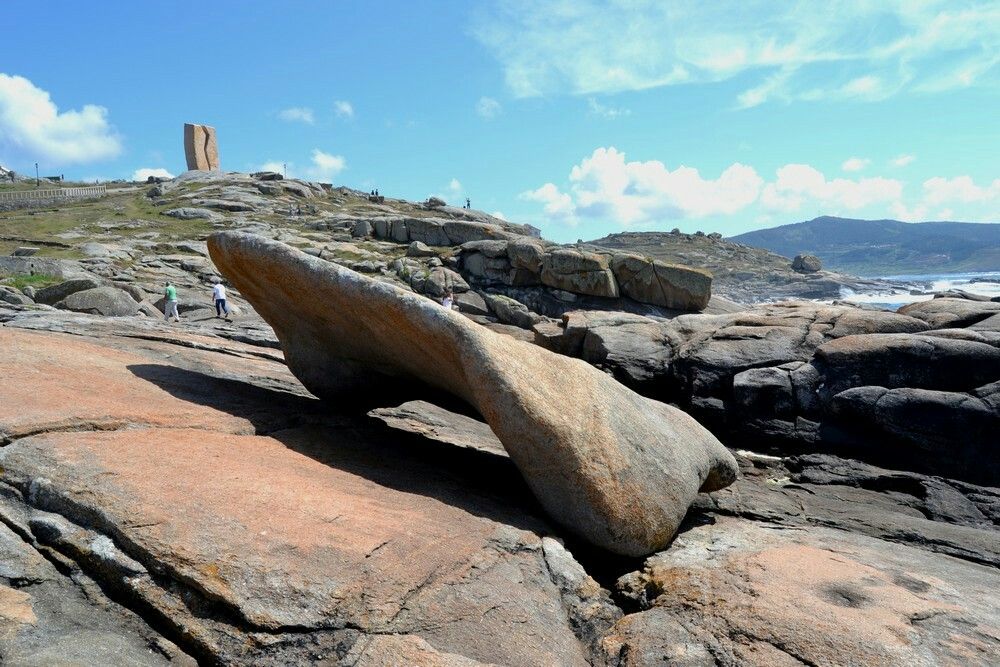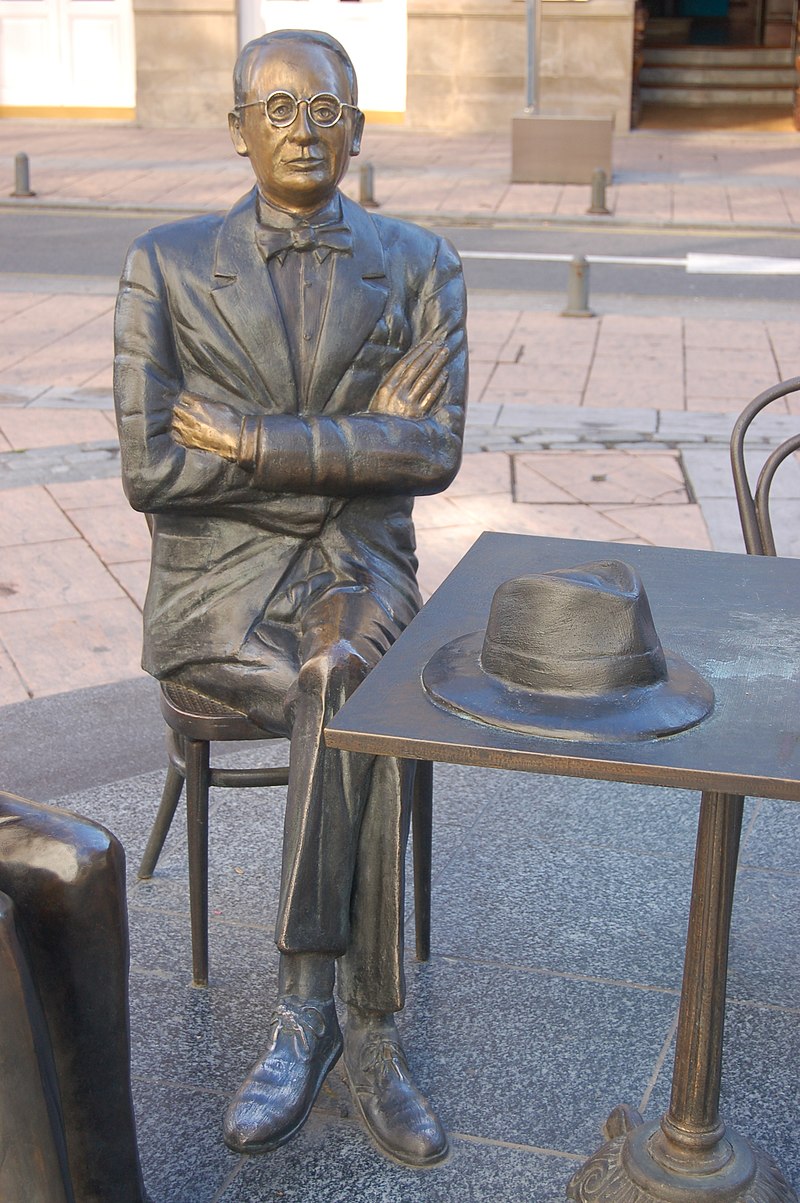Galicia is not mainstream Spain. It has always been separate as an older, less cosmopolitan, part of the Iberian Peninsula. For centuries Galicia was a byword for poverty and emigration, and its heritage granted it an equal status to Catalonia or the Basque country as a fringe society, but there has never been any argument in that Galicia one was amongst true Spaniards. They were probably here first; right after the end of the last Ice-Age. The rest of Spain has been overrun by many invaders whose feet first trod the earth in far distant lands, and whose mix of bloodlines has diluted the ancient Spanish recipe, but the invaders rarely spent much time in this far corner of Europe.

The castros of Santa Trega.
Part of Galicia’s economy then was based on iron and gold mines in the area and from fishing and harvesting the abundant shellfish in the many inlets or rias. Their Iron-Age settlements, now called castros, are scattered across the landscape of the north western corner of Spain. There are around five thousand castros in Galicia on hilltops and promontories, and many of these settlements are still being excavated by archaeologists.
Inhabited from around the 6th century BC, the oldest were built entirely of straw and mud, with later ones constructed in stone. Their roofs were made of cut poles and straw with compacted mud as filler. Pathways and streets between the houses were rarely straight, but curved or circular around the buildings These were fortified villages where outlying farmers or herders could retreat to in times of war and they were protected by pits and parapets with sometimes a torreón guarding the entrance. The castros were not isolated settlements, and were placed strategically near to rivers and arable land or on the border between low and high grazing pastures. Significantly, they were constructed to be within sight of other nearby castros so that warning signal fires could be seen in emergencies.
Their peak occupation was between the 4th and 2nd centuries BC. The Romans overran Galicia as they did most of the rest of Europe. However, that was not the end of the original Galicians. When the Romans left they re-emerged only to be briefly invaded again and suffer under the rule of the Moors until 740 when they were expelled from Galicia. From then on, apart from some brief periods of independence, Galicia was always ruled by the kings of Asturias, León or Castile, and its ancient language swept aside by Castilian. For five centuries, Galago was considered inculta, or uncultured.
Now the ancient language is undergoing resurgence with 83% of the population being able to speak it fluently as a second language. Compared with just 16% of Basques who speak euskara daily; this has been a quiet revolution for Galicia.
Their folklore goes back beyond Christianity to a time when other lesser demons roamed the world. There are no people in Spain more religious than Galicians, but although they go to church, they are traditionally very superstitious and have a pantheon of horrors lurking in the shadows. Meigas and Brujas abound, (good and bad witches) and mysterious beings called mouros, who hide treasure beneath the abandoned Iron-Age castros. Death, the afterlife and purgatory predominate in the legends, and there is supposedly a band of tortured souls called the Santa Compaña who are trapped in purgatory and who roam the country roads seeking a way to redeem their souls. The bestiary is at least as large as the lost souls group, and some of them are real. It includes lobishomos (werewolves) and mouchas, melodic owl-like creatures whose call announces an imminent death. The fishermen also have their own demons to face in the form of nereidas, beautiful but deceptively evil women of the sea.
However, many of the wolves are real, and have survived in freedom well into the twentieth century. A new plan to re-wild the forests of Asturias and Castilla-León has resulted in an eco-overspill into Galicia, and their numbers there are believed to be in excess of 500, with a total number for Northern Spain of around 2,000. Wolves have been a very real danger to humans in the past, and near the town of Berdoias there is a stone cross on a rock where, as legend has it, a pilgrim monk on his way to Santiago de Compostela was cornered and devoured by a pack.
There are places of mystery in Galicia, the history of which only the silent stones can tell. Built on a promontory jutting out into the ria de Camerinas, the remote Santuario da Virxe da Barca has attracted thousands of pilgrims as part of the Camino de Santiago. Originally a pre-Christian Celtic shrine, the ancient people who worshipped here resisted the conversion of Spain to Catholicism until the 12th century. To them, the strange concave slabs of rock called pedras, that surround the hermitage had both names and magical powers. The Christians originally built a hermitage here, and later, in the 17th century, the church. After the conversion to Catholicism, the mystery that surrounds the stones became New Testament and not pagan, and the pedras at A Barca were claimed to be the remains of a stone boat that brought the Virgin Mary here to encourage St. James with the evangelisation of Spain. The legends do not make it clear whether this was the same stone boat that brought St. James’ remains to Santiago or another, but there is a small harbour and village nearby called Muxia which may have been the landing point. The stones are displayed around the church like the outdoor exhibition of a surrealist sculptor, and I am not suggesting divine comment on the stones or the church, but the church was destroyed by lightning on December 25, 2013 and has since been restored.

The Pedra de Ablar can be rocked if sufficient people stand in a certain place on its surface, and has in the past provided yes-no answers to important questions.

Pedra de Cadris
The Pedra de Cadris has a low, wide opening eroded through it, and people with suffering with kidney, back pains or rheumatism scramble through it hoping for a cure. Eighteenth-century Catholic priests tuned a blind eye to this paganism, but when couples were copulating openly on the Pedra de Namorados stone that was deemed to have powers of fertility they campaigned to put a stop to it.
Certainly the Galician character has endured the centuries. One of the more well-known Galician characteristics is retranca, a devious refusal to let others know what you are thinking or doing. If you ask a Galician his opinion he will say Depande … (that depends). A Spanish saying illustrates this characteristic with the observation that if you meet a Galician on a staircase it is impossible to tell if he is going up or down. The confusion is compounded with the official adoption of Galego for the road signs. Galicia’s unmarked county roads will wind through aldeas (hamlets), which are governed by concellos (councils) with sometimes different ecclesiastical parroquias (parishes) and finally lugares, which seem to be the same thing as aldeas. On the next level up, there are four Galician provincias, which are divided into a dozen or so comarcas, which sometimes share the same name with one of the smaller subdivisions. This all leads to more confusion for an outsider who sees the same name repeated for different places. Even the Galego-Castilian dictionaries cannot agree on the meanings of words, and many visiting Spanish come away with the sneaking suspicion that they have been lied to, or worse, made fun of. It is not beyond the realms of possibility that the confusing road signs are a joke played on all non-Galicians.
Strangely, half of the place names in Spain are Galician. Galicia has 25,000 of them, but the names excel in beauty as well as numbers. There are Galician valleys called Silence, Sea, Love and Gold, and towns with names like Pin, Goo, Zoo and Bra, but also ominous names like The Mouth of Hell and Sacred Peak. On the border with Portugal is a forest which bears the beautiful name of A Fraga de Escuro Vermello, The Deep Red Forest.
Most Galicians like to believe that they have Celtic origins, but the philosopher Miguel Unamuno wrote in 1911 that this was the result of: “self-interested tinkering with history by nineteenth-century Galician Romantics.” The truth is that the pre-Roman Galicians certainly had trading ties with Brittany, Ireland and other Celtic areas, and modern genetic research shows a shared gene-pool of the European Atlantic countries, including Galicia and the Basques. There is even an ancient pre-eleventh-century Gaelic text called the Lebhar Gabhala (The Book of the Invasions) which claims that Ireland was once invaded and overrun by the Galicians. This improbable army was called “The Sons of Mil” and according to the legend, they conquered all of Ireland in a single day. Whatever the truth is does not matter, the fable is intertwined with modern reality and Vigo’s football club is called Celta de Vigo. At the foot of the above mentioned old Roman lighthouse, the Tower of Hercules, lies a huge round modern mosaic, the rosa de los vientos , a huge wind compass carries the symbols for the world’s Celts including Irish, Cornish and Bretons, and bagpipe players here are as common here as in Scotland.

Sculpture of Rodriguez Castelao
Before the Spanish Civil War, Galicia was well on the way to becoming autonomous from Spain when Rodriguez Castelao, the father of Galician nationalism, and one of the founders and president of the Galicianist Republican Party presented the results of a referendum for the Galician Statute of Autonomy which had been approved by 98% of Galician voters. He travelled widely to gain support for the Spanish Republic against the Nationalists led by Franco. Finally, in 1946 he was appointed as the Minister of the Spanish Republican government in exile in Paris, but a year later he was diagnosed with lung cancer in Buenos Aires and died there in 1950 at the hospital Centro Gallego.
Castelao once wrote: the Galician does not protest, he emigrates, but Castelao was not the only Galician forced to emigrate to the New World. During the nineteenth century Galicia was reduced to abject poverty and an estimated 900,000 left for the Americas. Another million emigrated during the 20th century, when boys as young as twelve were shipped off, most of whom could neither read nor write. Some survived and even prospered, but they never forgot their homeland. In Latin America today those of Spanish origin are still called Gallegos.
For those who remained, life in the famine became unendurable, and in 1853 Rosalia de Castro, who was a child at the time, remembered the sight of hungry masses begging for food in her home town of Santiago de Compostela. Her husband, the writer Manuel Murgia, wrote that the scenes were repeated in 1880 when: “the inhabitants of Luago ate grass”. Poor, desperate and easily exploited, the rest of Spain treated the Gallagoes with contempt for centuries. Their only virtue was considered to be a strong back and an obedient attitude. Mariano José de Larra, a nineteenth century Madrid commentator, wrote: The Galician is a very similar animal to a man, invented to relieve the ass.
For those who did escape to a new life in the Americas life was still hard, but not cruel, and a group of them who had emigrated to Cuba formed a charity to fund school building in the small pueblo of Santo Tome; their home town. Situated in a beautiful valley named with typical Galician eloquence, El Valle de Oro, the villagers will confess that there was probably not a single family that did not have a relative in Cuba, but not every emigrant prospered or even survived. The stark truth is that the biggest Galician graveyard is the Cristóbal Colón cemetery in Havana.
Nevertheless, the Valle de Oro charity gave money for schools with the encouraging words that:“Esquela que se abre,celda de carcel cierra”. (For every school that opens, a prison cell closes) and there are photographs of the returned émigrés in suits with their hair neat and oiled alongside the peasants dressed in their thick woollen trousers and collarless shirts with their buttons done up to the top. Those who return from Cuba to spend the final part of their life in their home village invariably can afford the larger houses in the village. A sign of their Cuban status and affluence is to plant a palm tree in the garden. Strangely, unlike the Basque countries or Catalonia, only one in thirty of present-day Galicans wants a separate state.
To be continued. Much of the above was taken from The Ghosts of Spain by Giles Tremlet. The rest was from Wikipedia.